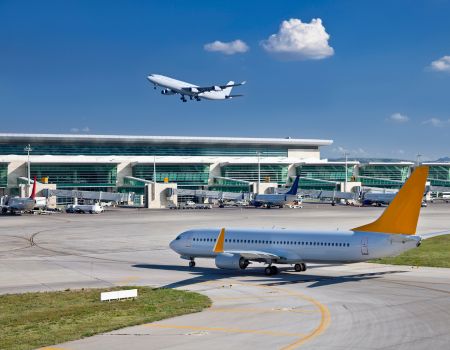As airports around the world launch terminal expansions, air mobility projects, and new conveniences for passengers, U.S. airports face mounting pressure to meet increasingly elevated expectations. U.S. airports are responding by investing in a wave of modernization and innovation efforts designed to improve the passenger experience, enhance safety, produce more operational efficiency and provide long lasting sustainability.
Frequently seen modernization efforts include the construction of solar-powered runways and electric aircraft hubs which require specialized infrastructure to support electric aircraft. Officials are also aggressively installing new mobility and transport options, high powered charging stations, and new sources of renewable energy power, while exploring alternatives to improve runway and local air safety.
San Antonio International Airport’s new parking structure includes a landing pad for eVTOL (electric vertical takeoff and landing) aircraft—commonly referred to as flying taxis. Los Angeles, Orlando, and Miami are exploring similar initiatives. Meanwhile, the FAA is supporting airport initiatives focused on research programs to regulate and promote advanced air mobility corridors.
Digital transformation is also reshaping passenger flow and security. Airports in Atlanta and Detroit are deploying biometric screening for passenger security, self-service kiosks for boarding passes, and digital twin models that simulate crowd movement to optimize gate usage.
Inspired by European models, airport officials in the U.S. are exploring remote and virtual control towers with a technology already live in the U.K. and Sweden. A remote tower system uses a network of high-definition cameras, sensors, and high-tech communication systems to provide air traffic controllers with a comprehensive, real-time view of the airport and all its surroundings, even if a controller is not physically located in a traditional control tower.
Public-private partnerships (P3s) are frequently being leveraged to fund this wave of costly change. From LaGuardia’s Terminal B, which received $4 billion via a private sector investor group, to Denver’s Great Hall upgrades, airports are tapping into private capital to deliver when public funding resources are lacking. Realistically, this approach is both practical and necessary, as America’s airports must remain competitive in the global marketplace. The following upcoming opportunities offer similar contracting opportunities at airports throughout the country.
Officials at Orlando International Airport are setting the stage for a new era in urban transportation with a plan to develop a state-of-the-art vertiport designed specifically for electric vertical takeoff and landing aircraft. Although the Greater Orlando Aviation Authority has not yet disclosed the total project cost, it is anticipated that funding will come from a combination of public and private sources.
Strategically located on the airport’s East Airfield, the vertiport will serve as a key infrastructure element to support the emerging eVTOL industry. The initiative will ease ground traffic congestion, provide regional connectivity and elevate Orlando’s broader objective of turning the airport into a Verti hub of the future, where traditional transportation systems like Sun Rail and Brightline seamlessly integrate with aerial transit solutions. Solicitations will be released with the intent to begin construction in 2028.
The Port Authority of New York and New Jersey has committed $55 million to begin the redevelopment of Terminal B at Newark’s Liberty International Airport. The funding will support the initial design, engineering, and infrastructure planning to modernize the aging terminal and improve the airport’s overall efficiency and capacity. Currently, the total anticipated cost of this initiative is approximately $2.7 billion.
With approximately 12.3 million passengers flying in and out of the airport each year, the existing terminal can no longer accommodate passenger demand. The broader plan also includes roadway redesigns, taxiway enhancements, and other terminal improvements. The planning and design phase for the new Terminal B is expected to span the next two to three years but once completed, full-scale construction will follow, likely beginning in 2028.
In Oregon, the Redmond City Council has approved a $117.8 million terminal expansion project at Roberts Field, also known as Redmond Municipal Airport. The expansion will triple the size of the airport’s current commercial concourse in response to the region’s fast-growing air travel demands. Along with seven new jet bridges, roughly 80,000 square feet of new space will be added, featuring expanded seating areas and over 6,000 square feet dedicated to retail and concessions.
The project will also improve accessibility and traveler comfort with designated relief areas for service animals, wider walkways, and improved vertical transportation with more elevators and escalators. Plans also call for solar panels, upgrades to energy-efficient HVAC systems, and the pursuit of LEED Silver certification for the project. With approval for funding recently passed, solicitations and construction are expected to take place before the end of 2025.
The North Dakota Aeronautics Commission has approved $81.6 million in state airport infrastructure grants to support a wide range of upgrades for public-use airports. The funding covers numerous individual projects, most of which are needed to meet increased demand. The bulk of the funding, $78.1 million, will be directed toward capital improvement projects. Major recipients include Fargo’s Hector International Airport for a planned terminal expansion project, Dickinson’s Theodore Roosevelt Regional Airport for a new terminal, and Grand Forks International Airport for a significant runway reconstruction effort. The Bismarck Municipal Airport also has plans for a project that will include extensive taxiway renovations. Some projects will launch late in 2025 with others beginning in 2026 and 2027 depending on federal coordination and construction schedules.
Voters in Abilene Texas recently approved a $20 million bond to fund in part a $70 million terminal expansion and modernization project at the Abilene Regional Airport. The terminal will be expanded, and improvements will be made to the HVAC, elevators, baggage claim system, and fire suppression systems. Project components will call for energy-efficient equipment, energy-saving windows and natural lighting. As part of the modernization, the Abilene airport will also implement facial recognition technology in the security screening system. Reconfiguration of the terminal will relocate airline and car rental counters to the first floor and add a partially enclosed balcony to the expanded boarding area. The expansion project is timely because Abilene was selected to host a $500 billion federal AI initiative which will result in elevating the mid-sized city to a larger leadership role and it will likely become a hub for innovation and AI infrastructure. Currently, the project is in the design phase and while no timelines for solicitation releases or construction starts have been announced, officials appear eager to get started.
As U.S. airports respond to evolving passenger expectations, global competition, and the rapid pace of technological change, they are embracing modernization at an unprecedented scale. Contractors who provide services to airports are already in high demand throughout America. And this wave of upcoming opportunities presents a clear signal: the runway for innovation and growth in the airport sector is wide open.
Photo Courtesy of Canva







